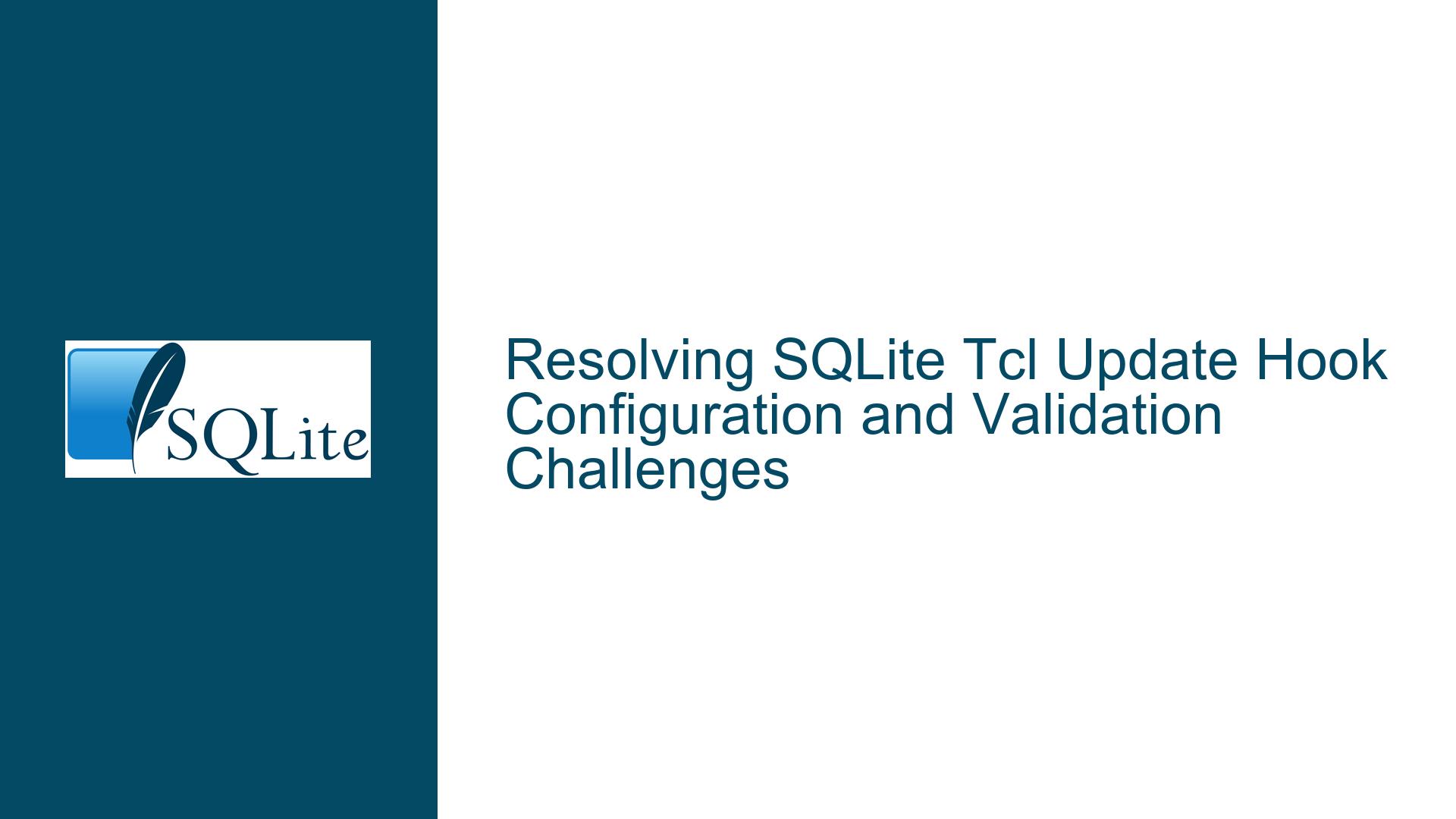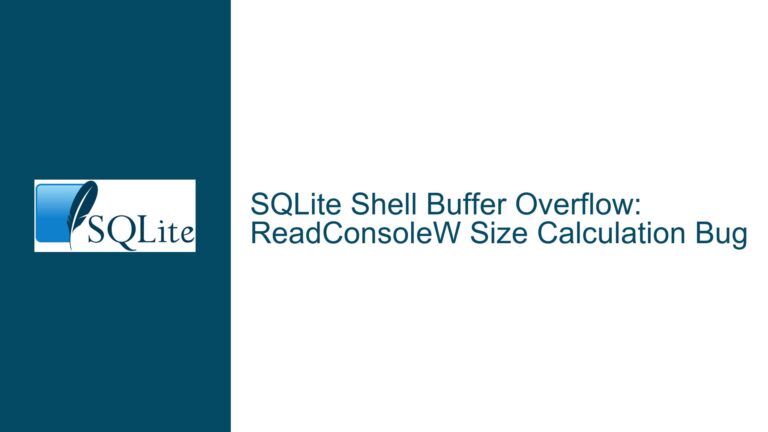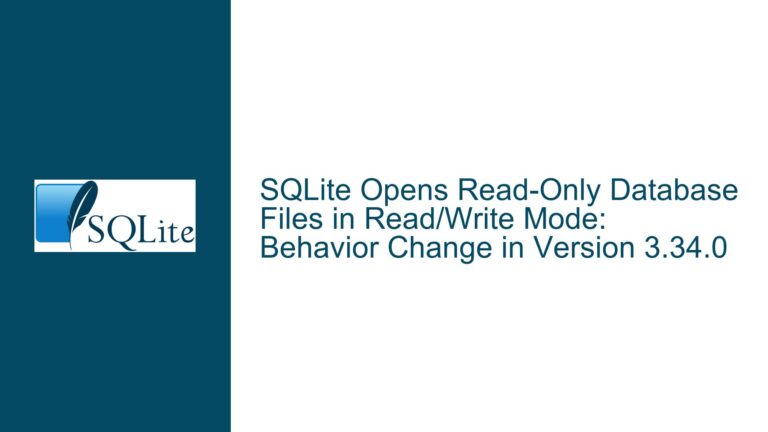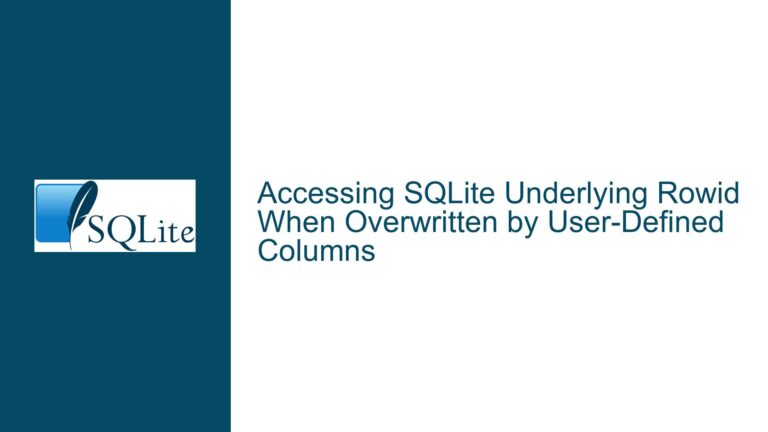Resolving SQLite Tcl Update Hook Configuration and Validation Challenges
Understanding Update Hook Limitations in SQLite Tcl Bindings
The primary challenge in this scenario revolves around configuring the update_hook and preupdate_hook mechanisms within the SQLite Tcl interface to enforce business logic validation during database operations. A developer attempted to use these hooks to intercept updates and inserts, intending to veto operations that violated specific rules. While the commit_hook worked as expected (triggering an error that rolled back the transaction), the update_hook and preupdate_hook did not exhibit the same behavior. This discrepancy led to confusion about whether the SQLite library was compiled without required options or if there was a fundamental misunderstanding of how hooks propagate errors back to the SQLite engine.
The test code provided demonstrates two critical observations:
- Commit Hook Behavior: When a
commit_hookscript raises an error (e.g.,expr 1 / 0), the error is captured by the SQLite engine, aborts the transaction, and surfaces the error in Tcl’serrorInfovariable. This allows developers to enforce transaction-level validation. - Update Hook Behavior: The
update_hookscript (when correctly configured) executes after a row is modified but does not influence the outcome of the operation. Errors raised within theupdate_hookare not propagated to SQLite, meaning the database engine proceeds as if no error occurred. The test code further complicates this by erroneously checking for theENABLE_PREUPDATE_HOOKcompile option before configuring theupdate_hook, which is unrelated to theupdate_hookfunctionality. This misstep caused theupdate_hookregistration to be skipped entirely, leading to a false "No error" result.
The core issue stems from two overlapping factors:
- Misconfigured Compile Option Checks: The
ENABLE_PREUPDATE_HOOKflag controls the availability of thepreupdate_hook, not theupdate_hook. By conditionally setting theupdate_hookbased on this flag, the test code inadvertently disabled the hook. - Error Propagation Mechanics: SQLite’s C API does not provide a mechanism for hooks like
update_hookto return errors to the database engine. Errors in these hooks are isolated to the Tcl interpreter and do not affect the SQL operation that triggered them.
This combination of configuration errors and misunderstood hook semantics creates a scenario where validation logic appears to fail silently or not execute at all.
Challenges with Error Propagation from Tcl Hooks to SQLite Engine
1. Hook Execution Context and Error Isolation
SQLite hooks operate within a specific execution context determined by their purpose. The commit_hook runs as part of the transaction commit process, giving it the ability to veto the commit by returning a non-zero value (in C) or raising an error (in Tcl). In contrast, update_hook and preupdate_hook are designed for observation rather than intervention. They execute after the modification (update_hook) or before it (preupdate_hook), but their return values do not influence the operation’s outcome.
In Tcl, errors triggered within these hooks are handled by the Tcl interpreter, not the SQLite engine. For example, a division-by-zero error in an update_hook script will terminate the Tcl callback but leave the SQL operation unaffected. This isolation ensures that database operations remain atomic and consistent, even if external scripts fail.
2. Compile-Time Configuration Misalignment
The ENABLE_PREUPDATE_HOOK compile option enables the preupdate_hook functionality, which provides detailed information about pending changes (e.g., old/new row values). However, the update_hook does not require this option. The test code incorrectly linked update_hook availability to ENABLE_PREUPDATE_HOOK, causing the hook registration to be skipped on systems where this flag was not set. This misconfiguration masked the underlying issue: even if the update_hook were registered, its errors would not affect the SQL operation.
3. Use Case Mismatch
Hooks like update_hook are intended for auditing, logging, or synchronizing external systems—not for enforcing business rules. Attempting to use them for validation creates a mismatch between their design and the developer’s goals. SQLite provides other mechanisms, such as CHECK constraints, triggers, and application-level transaction control, to handle vetoing operations based on business logic.
Implementing Workarounds for Update Validation in SQLite via Tcl
Step 1: Correcting Hook Configuration
Remove the conditional check for ENABLE_PREUPDATE_HOOK when configuring the update_hook. The update_hook is always available in standard SQLite builds and does not depend on this flag. Here’s a corrected version of the test code:
db update_hook { expr 1 / 0 }
catch { db eval { insert into person VALUES ('joe', 'bloggs') } } err
if {$err>0} { puts "Error was: $::errorInfo" } else { puts "No error" }
Running this will reveal that the update_hook executes (triggering an error), but the INSERT operation still succeeds. The error appears in errorInfo, but SQLite does not roll back the change.
Step 2: Leveraging Triggers for Validation
SQLite triggers can enforce business rules by raising errors that abort the operation. For example, to prevent inserting a row with fname = 'joe':
db eval {
CREATE TRIGGER veto_joe BEFORE INSERT ON person
BEGIN
SELECT RAISE(ABORT, 'Name "joe" is not allowed')
WHERE NEW.fname = 'joe';
END
}
catch { db eval { INSERT INTO person VALUES ('joe', 'bloggs') } } err
puts "Error: $err" ;# Output: Error: 1
puts "Message: [db error]" ;# Output: Message: Name "joe" is not allowed
Triggers integrate directly with SQLite’s transaction management, ensuring that errors roll back the current statement and transaction.
Step 3: Combining Hooks with Application Logic
If triggers are insufficient (e.g., when validation requires external data), use the update_hook to log issues and enforce validation at the application level:
db update_hook { op db table rowid ->
if {$op == "INSERT"} {
set fname [db eval {SELECT fname FROM person WHERE rowid = $rowid}]
if {$fname eq "joe"} {
puts "Invalid name detected; reverting transaction..."
db eval {ROLLBACK}
}
}
}
db eval BEGIN
catch { db eval {INSERT INTO person VALUES ('joe', 'bloggs')} } err
db eval COMMIT
Note: Manually triggering a ROLLBACK within the hook may lead to unexpected behavior, as the hook executes after the modification. A safer approach is to use a BEFORE trigger or validate inputs before executing the SQL statement.
Step 4: Compiling SQLite with Custom Hooks
For advanced use cases, consider extending SQLite’s C API to support error-propagation-capable hooks. This involves modifying the SQLite source to pass Tcl errors back to the engine. While beyond typical use, here’s a conceptual outline:
- Modify the
sqlite3_update_hookcallback intclsqlite.cto capture Tcl exceptions. - Propagate these exceptions to SQLite using
sqlite3_result_error()or similar functions. - Recompile the Tcl extension with the modified code.
This approach is not recommended for most users due to maintenance complexity but illustrates the flexibility of SQLite’s open-source design.
Final Recommendation
For most applications, triggers and check constraints provide the safest and most maintainable way to enforce business rules. Reserve hooks for non-critical tasks like logging or cache invalidation, where errors do not compromise data integrity.






